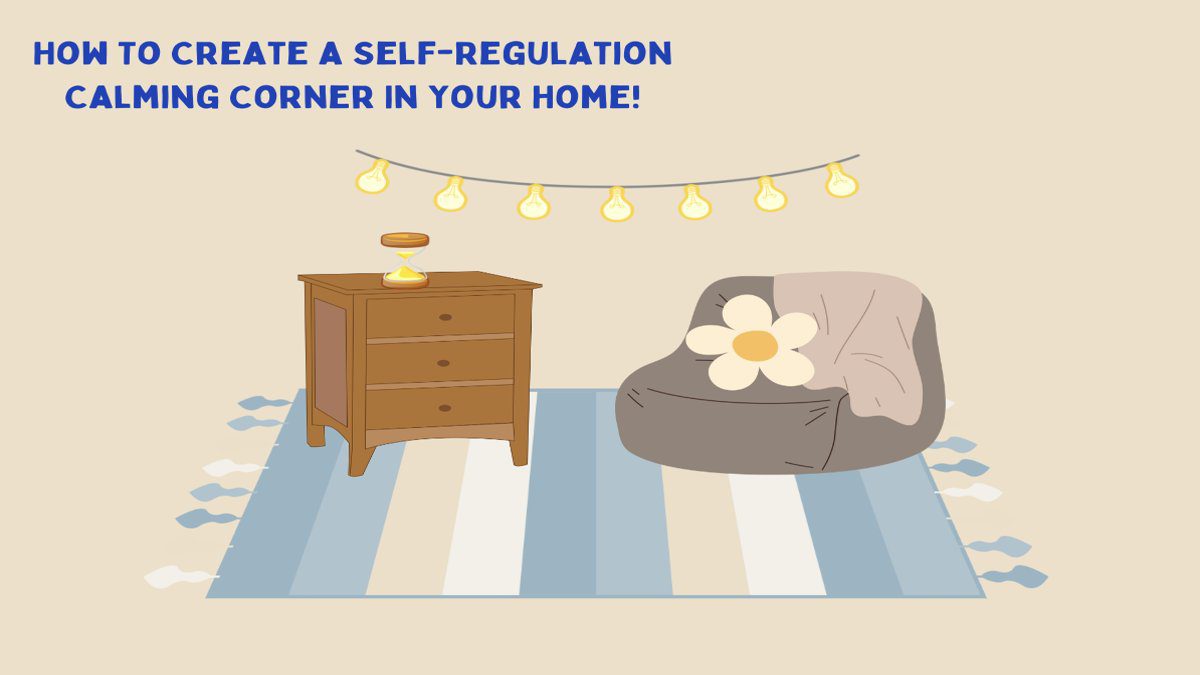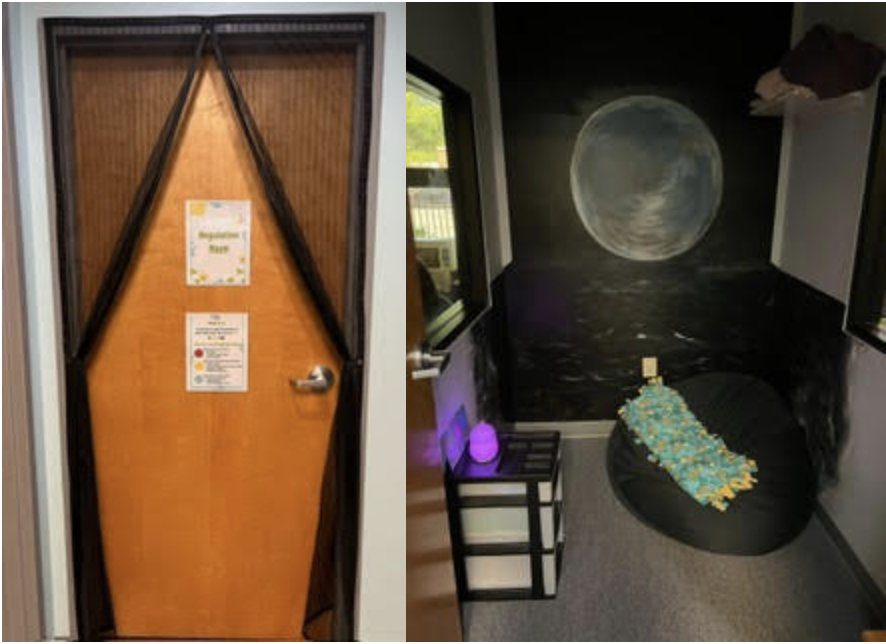When Kids Use A Calming Corner They Learn:
- It’s OK and normal to use healthy coping skills to cope with their emotions and manage stress.
- Resetting allows them to get back to having fun and enjoying what they were doing.
- They can handle challenges that come their way.
How to create an effective calming corner
- Team up with your child to decide how to create a space that will work best for them and what to name it (it could be as simple as the calming corner or the chill-out zone). The more input your child has in designing the space, the more likely they are to use it.
- Pick a comfortable location where your child feels safe using coping strategies without distractions. Select a quiet, low-traffic area of your home. This could be a corner of a room, a small nook, or even a designated room if space allows. The key is to make it a cozy, inviting spot.
- Provide structure and clear expectations (they help kids feel safe). Work with your child to establish clear guidelines for how the space should be used. It’s important that kids understand that the calming corner is not an excuse to escape chores or other responsibilities but rather a place to take a break and reset.
- Make agreements to determine:
- How long should your child stay in their calming corner? (You may want to put a sand timer in the space and have your child practice using it ahead of time so that they know how to start and end their time independently.)
- How should your child let you know if they need more time in the space?
- What behaviors are safe or unsafe in the space?
- Teeach coping skills. A strategy that works one day may not work the next, so teach your child lots of different coping skills. According to licensed therapist Jody Baumstein, LCSW, “You want your child to have multiple coping tools to choose from, but you also don’t want to overwhelm them with too many options all at once. Try introducing a few tools at a time and then building their toolbox as you go.” It is difficult to learn something new when we are anxious, angry or distracted, so teach and practice new coping skills when everyone is calm rather than in the heat of the moment.
- Practice coping skills regularly. Practice using each item or tool in the calming corner with your child before they use the space on their own. Whether it is practicing yoga poses, belly breathing or squeezing a pillow, make sure your child knows how to confidently use the different coping strategies on their own.
How Should The Claming Corner Be Used?
- Set a positive tone for the space. Make sure the space is not used for punishment so that your child does not feel any shame or hesitation about using the space.
- Encourage independence. There may be times when you feel your child does not need to use the calming corner or is using it to avoid chores or other activities. In these instances, remember that the goal of the space is for your child to be able to use it independently. Allowing your child to decide when and how to use their space shows trust and gives them the ability to identify (on their own) when they need a break or to use coping strategies.
- Try not to push the space too hard. If you think your child would benefit from the calming corner but isn’t using it, try encouraging them instead of forcing or persuading them.
- Adjust as needed. If you notice that your child rarely wants to use the calming corner, something may not be working. Have an open conversation with your child about why they’re not using the space.
Some Ideas You May Add To The Space
- Lighting: Use soft, adjustable lighting such as fairy lights or a small lamp with a dimmer. Avoid harsh or bright lights.
- Color Scheme: Opt for calming colors like soft blues, greens, or neutrals. These colors can have a soothing effect on children.
- Sound: Add a white noise machine or soft, calming music. Some children may benefit from nature sounds or gentle lullabies.
- Seating: Use comfortable seating options like bean bags, a small tent or canopy, or a soft floor mat where your child can sit or lie down.
- Comfort items: Whether it’s a soft bath mat, blanket, pillow, or beanbag, create a comfortable and cozy place to sit. Offer another comfort item, such as a stuffed animal, for them to hold.
- Glitter jar: Combine clear glue, water, and glitter to create a glitter jar representing how emotions can feel in our bodies (settled glitter represents calm and shaken glitter represents big emotions). When your child is feeling strong emotions, they can shake the bottle and concentrate on slowly breathing in and out as the glitter settles.
- Pinwheels or bubbles: Pinwheels and bubbles can be used to help your child focus on breathing in and out in a slow, relaxing way. Encourage them to inhale in through their nose and then exhale out their mouth as they blow on the pinwheel or blow bubbles.
- Stress balls: Having something to squeeze can help your child work out any tension in their body.
- Play-Doh: Playing with Play-Doh can be calming for children because it allows them to shift their focus, express themselves, and release tension.
- Sensory Bins: Create sensory bins filled with materials like rice, beans, or sand. These can provide hands-on sensory experiences.
- Coloring pages: This is a great tool for kids of all ages (and adults, too). Some kids find the rhythmic motion of coloring to be soothing, and others use it as a form of self-expression.
- Yoga poses or stretches: Yoga and stretching can help release tension and stress.
- Visual reminders of feelings and coping skills: Whether it’s pictures of friends and family expressing different emotions and practicing coping skills, or sticky notes with the words written on them, sometimes it helps to have a visual reminder of what your child can do in their calming corner.
Examples of spaces in the home
- Cozy Corner: Transform a small corner of a living room or bedroom with a comfy chair or bean bag, soft lighting, and sensory toys. Add a small shelf for calming tools and books.
- Under-the-Stairs Nook: Utilize an under-the-stairs space by adding a small tent or canopy, soft pillows, and sensory items. This can become a cozy hideaway for your child.
- Bedroom Sanctuary: If space allows, convert part of your child’s bedroom into a sensory and calm down area. Use calming colors, a comfortable mat or bed, and personalized sensory tools.
- Playroom Retreat: Dedicate a section of the playroom to be a calm-down space with interactive sensory bins, a soft play area, and soothing visuals.
Creating a sensory and calm down space at home can provide your child with a valuable tool for managing their sensory needs and emotional well-being. With a few thoughtful additions and adjustments, you can create a peaceful haven that supports your child’s development and helps them thrive.
If you need further guidance on setting up a sensory space or have any questions about your child’s sensory needs, feel free to reach out to our clinic. We’re here to support you and your child every step of the way!


